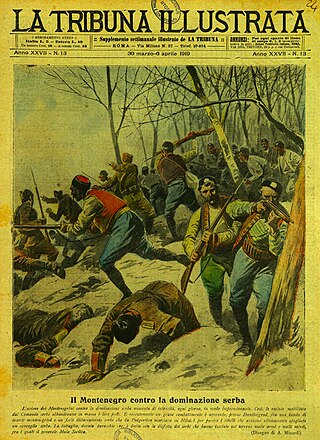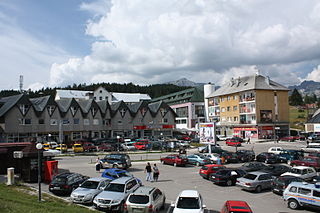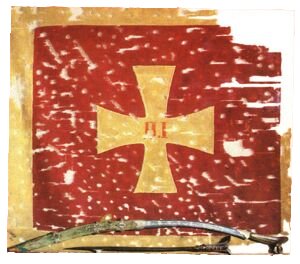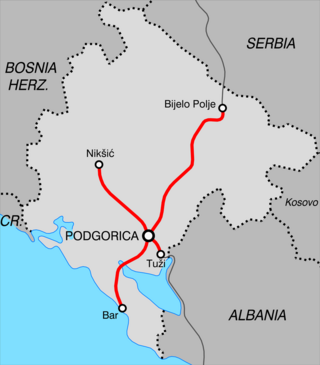
Podgorica is the capital and largest city of Montenegro. The city is just north of Lake Skadar and close to coastal destinations on the Adriatic Sea. Historically, it was Podgorica's position at the confluence of the Ribnica and Morača rivers and at the meeting-point of the fertile Zeta Plain and Bjelopavlići Valley that encouraged settlement. The surrounding landscape is predominantly mountainous terrain.

Nikšić, is the second largest city in Montenegro, with a total population of 56,970 located in the west of the country, in the centre of the spacious Nikšić field at the foot of Trebjesa Hill. It is the center of Nikšić Municipality with population of 72,443 according to 2011 census, which is the largest municipality by area and second most inhabited after Podgorica. It was also the largest municipality by area in the former Yugoslavia. It is an important industrial, cultural, and educational center.

The Christmas Uprising, also known as the Christmas Rebellion, was a failed uprising in Montenegro led by the Greens in early January 1919. The military leader of the uprising was Krsto Popović and its political leader was Jovan Plamenac.

Tuzi is a small town in Montenegro and the seat of Tuzi Municipality, Montenegro. It is located along a main road between the city of Podgorica and the Albanian border crossing, just a few kilometers north of Lake Skadar. The Church of St. Anthony and Qazimbeg's Mosque are located in the centre of the town. Tuzi is the newest municipality in Montenegro, having been an independent municipality since 1 September 2018.

Danilovgrad is a town in central Montenegro. It has a population of 6,852, according to the 2011 census. It is situated in the Danilovgrad Municipality which lies along the main route between Montenegro's two largest cities, Podgorica and Nikšić. Via villages, Danilovgrad forms part of a conurbation with Podgorica.

Žabljak is a small town in northern Montenegro. It has a population of 1,723.

Kolašin is a town in northern Montenegro. It has a population of 2,989. Kolašin is the centre of Kolašin Municipality and an unofficial centre of Morača region, named after Morača River.

Danilovgrad Municipality is one of the municipalities of Montenegro. The administrative center is the town of Danilovgrad. The municipality is located in the central region of Montenegro in the valley of Zeta river, sometimes called also the Bjelopavlići plain, after the name of the local tribe.
Albanians in Montenegro are an ethnic group in Montenegro of Albanian descent, which constitute 4.91% of Montenegro's total population. They are the largest non-Slavic ethnic group in Montenegro.

The Armed Forces of Montenegro are the military forces of Montenegro. The Armed Forces consists of an army, navy and air force.

The Montenegrin–Ottoman War, also known in Montenegro as the Great War, was fought between the Principality of Montenegro and the Ottoman Empire between 1876 and 1878. The war ended with Montenegrin victory and Ottoman defeat in the larger Russo-Turkish War of 1877–1878. Six major and 27 smaller battles were fought, among which was the crucial Battle of Vučji Do.
Fudbalski klub Zora is a Montenegrin football club based in Spuž, Danilovgrad Municipality. They currently compete in the Montenegrin Third League.
The Third League of Montenegro is the third and lowest-tier football league in Montenegro. It is headed by the regional unions of the Football Association of Montenegro, under the Football Association of Montenegro. In the 2020-21 season, 30 teams participated, divided into three regions. The top team from each region qualifies for the playoff from which the top team qualify for the Second League of Montenegro.
The Montenegrin First League of Women's Handball is the top women's team handball league in Montenegro. It is organised by the Handball Federation of Montenegro.
The Montenegrin Men's Handball Cup is an elimination handball tournament held annually. It is the second most important national title in Montenegrin handball after the Montenegrin First League.

The Nikšić–Podgorica railway is a railway connecting Montenegro's capital Podgorica and the country's second largest city, Nikšić. The line connects to the Belgrade–Bar railway and the Podgorica–Shkodër railway at Podgorica. It is operated by ŽICG.
Brda refers to a historical and ethnographical region in Montenegro. The Brda are one of the country's four historic tribal regions, along with Old Montenegro, Old Herzegovina and the Montenegrin Littoral. The historical tribes of the Brda are the Vasojevići, the Bjelopavlići, the Piperi, the Kuči, the Bratonožići, the Moračani and the Rovčani. Collectively known as "the seven tribes" or "the seven hills", they were referred to as "Highlander tribes" before their gradual integration into Montenegro, from the late 18th to the early 20th century. As a result, members of these tribes are also often called "Highlanders".
Prva Crnogorska futsal Liga is the highest-ranked futsal league in Montenegro. It is governed by the Football Association of Montenegro and it is played under UEFA and FIFA rules. It was founded in 2006 and as of 2019–20 season, the league consists of 10 teams.
Stanjevića Rupa is a village in the municipality of Podgorica, Montenegro. It is located near Spuž, Danilovgrad Municipality.











